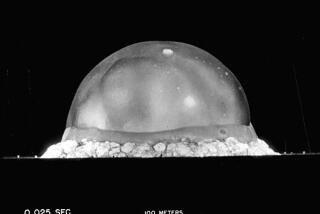Book Review : Rabi Biography: It Has a Real Common Problem
- Share via
Rabi: Scientist and Citizen by John S. Rigden (Basic Books: $21.95; 302 pages)
I. I. Rabi is one of this country’s most distinguished physicists, and at the age of 88 (soon to be 89), his life has encompassed all of this century and the revolution in physics that it produced.
As a young man, Rabi studied in Europe and was involved in the development of quantum theory, and he won a Nobel Prize in 1944 for research conducted after his return to the United States.
During World War II he was part of the Radiation Laboratory at MIT that developed radar, and he was a frequent consultant to the atomic bomb project at Los Alamos, N.M. After the war, he was one of the many physicists who tried to prevent the development of the arms race but whose pleas were ignored.
Along the way, Rabi was involved with the greats of physics (Albert Einstein, Enrico Fermi, Hans Bethe, J. Robert Oppenheimer, et al). In the postwar era, he was involved with the country’s political leaders, notably Dwight D. Eisenhower, whom he first met when Eisenhower was president of Columbia University, Rabi’s home base for more than half a century.
Interesting Story
All of this makes for an interesting story, ably told by John S. Rigden, a physicist at the University of Missouri-St. Louis.
But the trouble with many scientific biographies--this one included--is that they fail to get inside the man (or woman) under study. The names and dates and explanations of the science are right, but the totality does not add up to a whole person.
The most successful chapter in the book is the one on Rabi and Oppenheimer, who was Rabi’s good friend though they were very different. That is the best part of the book because of its portrait of Oppenheimer, an extremely complex and fascinating man who, Rigden argues, was the cause of his own downfall. It is also the part of the book where Rigden explores Rabi’s personality, which he does by comparison with Oppenheimer’s.
“Rabi and Oppenheimer: many parallels, basic differences,” Rigden writes. “Both men deeply concerned with the events of their day; both men eager to do good for the sake of the future. Rabi, the wise; Oppenheimer, the more brilliant. Rabi the effective operator behind the scenes; Oppenheimer, the eloquent spokesman.
“Of all their similarities and of all their differences, it is perhaps the sense of identity, to themselves and to others, that separates the two men most decisively. If Rabi and Oppenheimer, like Humpty- Dumpty, each fell from a wall and shattered into many pieces, the King’s men would never be able to restore the splintered brilliance of the original Oppenheimer. For Rabi, the king’s men would have it easy: the pieces fit together in only one way.”
History of Science
And therein lies the problem of the book, which is no fault of Rigden. Rabi’s physics and his efforts on behalf of science and society are more interesting than he is. The reader doesn’t get much sense of the man who was doing these things. What were his motivations, fears, and doubts? If he had none, why not?
But this complaint is not meant to dismiss the book. The story of the development of quantum theory is a tremendously important event in the history of science, and, while that story has been told many times, it doesn’t hurt to tell it once again from the perspective of yet another participant.
Similarly, the story of the efforts--and failure--of scientists to persuade political leaders to contain atomic weapons after World War II is one of the saddest and most frustrating episodes of 20th Century science. Rabi was in the forefront of these efforts, particularly through his membership on and eventual chairmanship of the General Advisory Committee of the Atomic Energy Commission, which urged President Harry S. Truman not to go ahead with the H-bomb.
Rigden and Rabi blame Truman for not getting sufficient scientific advice and for not understanding the issues that were before him when he approved the H-bomb project. “He simply did not understand what it was about,” Rigden quotes Rabi as saying.
“Rabi: Scientist and Citizen” has many interesting tidbits, and the story it recounts is a vital part of current history. But if you want to know about human nature and what makes people tick, better to read Dostoyevsky.
More to Read
Sign up for our Book Club newsletter
Get the latest news, events and more from the Los Angeles Times Book Club, and help us get L.A. reading and talking.
You may occasionally receive promotional content from the Los Angeles Times.










